Beginner-Friendly Travel Guide for Australia – Everything You Need
Published: 23/10/2025
Australia is a vast and amazing country, full of adventures waiting for every traveler. From lively cities like Sydney and Melbourne, to stunning beaches, the remote Outback, and the colorful Great Barrier Reef, there is something for everyone.
In this Australia travel guide, you will find everything you need to plan your trip: tips on the best cities and regions to visit, how to get around, local food and drinks, wildlife you can see, shopping and store timings, visa and entry information, and important safety advice.
Whether it is your first visit or a return trip, this guide will help you travel confidently, enjoy every moment, and make your Australian adventure unforgettable.
So, let’s start our Travel Guide for Australia and discover everything this amazing country has to offer.
Why Visit Australia?
Australia isn’t just another country on your travel list — it’s a whole mix of nature, adventure, and culture packed into one massive island. Whether you love beaches, wildlife, or big cities, this country gives you a little bit of everything.
You can dive into the Great Barrier Reef, hike through the Blue Mountains, or watch the sunset over Uluru in the red desert. The cities are modern and full of life — Sydney offers stunning harbor views, Melbourne has arts and coffee culture, and Adelaide gives you peaceful charm and wine country just an hour away.
Australia’s laid-back lifestyle is another reason travelers fall in love with it. People are friendly, food is great, and the air feels fresh wherever you go. Plus, it’s one of the safest and cleanest countries to travel in.
If you enjoy road trips, Australia’s long highways and open landscapes are pure freedom on wheels. And for wildlife lovers, seeing kangaroos, koalas, or the cute quokkas in their natural home is something you won’t forget.
In short, Australia is the kind of place where you can relax, explore, and feel completely alive — all in the same trip.
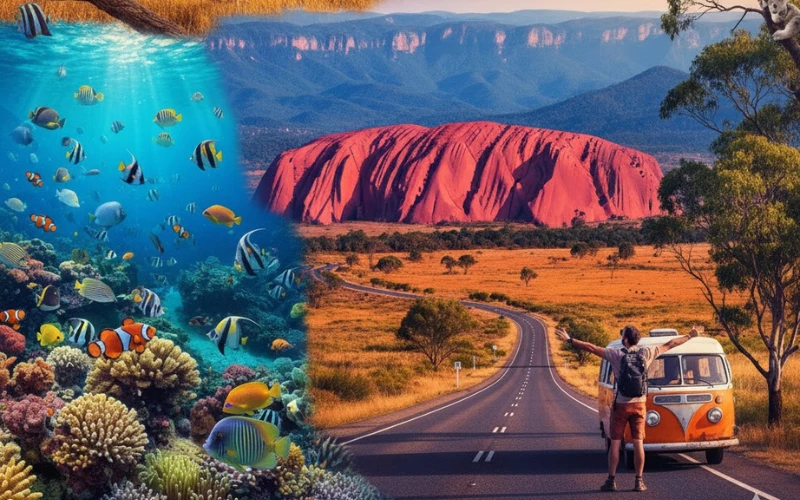
Size & Geography of Australia
Australia is the sixth-largest country in the world, but it has only about 25 million people. Traveling across the country can take a lot of time. For example, driving from Brisbane on the east coast to Perth on the west coast takes about three days, or five hours by flight.
The country has a mix of coastal cities, islands, and the Outback, which is a vast inland area with deserts, natural rock formations, and Indigenous heritage. Unlike “the bush,” which is semi-rural land near cities, the Outback is remote and undeveloped.
Tasmania, an island south of the mainland, is part of Australia. It is famous for its rugged wilderness, unique wildlife, and stunning landscapes.
Major Cities & Regions
Australia is a country of contrasts, and its cities and regions each have their own personality.
Sydney
The first stop for many visitors, Sydney is alive with energy. With 5.3 million people, it’s famous for the Sydney Opera House, the Harbour Bridge, and sun-soaked beaches like Bondi and Manly. Even a short walk along the harbor will make you fall in love with the city.
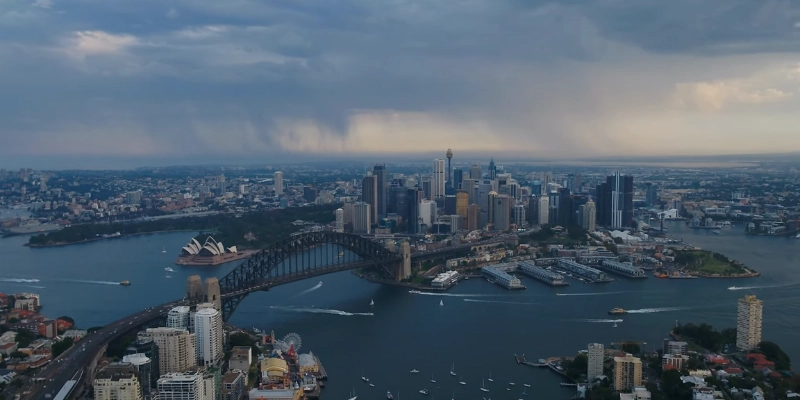
Melbourne
Just a short flight away, Melbourne has a completely different vibe. Known for its coffee culture, art-filled laneways, and passionate sports fans, it’s the city to explore on foot. Hidden cafés, street art, and cultural festivals make every visit feel fresh and exciting.
Canberra
Australia’s national capital feels calm and organized, with a population of around 460,000. Planned like Washington, D.C., it’s full of museums, galleries, and beautiful green spaces — a perfect mix of city life and culture.
Adelaide
Nestled on the south coast, Adelaide is called the Festival City for a reason. With 1.3 million people, it’s a relaxed yet lively destination, and its nearby wine regions make it ideal for food and wine enthusiasts.
Perth
On the western edge of the country, Perth is all about sunshine, beaches, and a laid-back lifestyle. The city feels open and airy, with unforgettable views of the Indian Ocean.
The Outback
For a completely different experience, head inland to the Outback. It’s vast, wild, and full of deserts, rugged landscapes, and Indigenous heritage sites. Visiting here is a chance to see the heart of Australia and try adventures you can’t find anywhere else.
Great Barrier Reef Region
Off the northeast coast lies one of the world’s natural wonders. Stretching 2,600 km, the Great Barrier Reef is perfect for snorkeling, diving, or simply enjoying the tropical islands and colorful marine life.
Each region offers something unique — from urban charm to untouched nature — giving travelers a true taste of Australia’s diversity.
For travelers, cities offer culture, food, and nightlife, while regions like the Outback and the Reef provide natural beauty and adventure.
Top Picnic Points in Australia
Australia is made for outdoor lovers. Whether it’s a lazy afternoon under shady trees or a quiet lunch with ocean views, you’ll find picnic spots almost everywhere. The best part? Each one feels a little different — some wild, some calm, all beautiful.
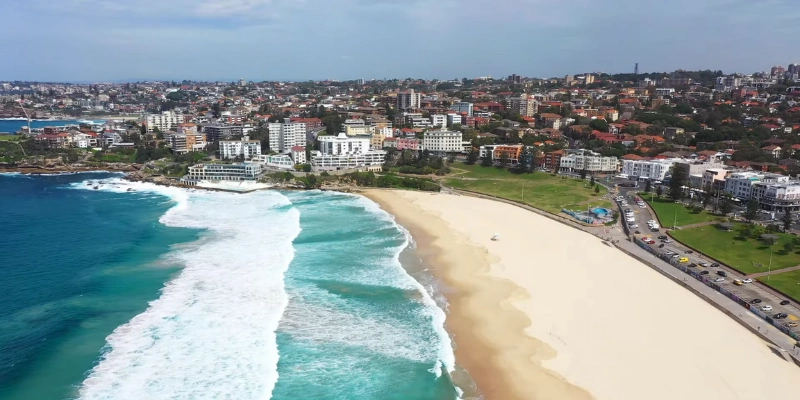
1. Royal Botanic Garden – Sydney, New South Wales
Few places in the world let you picnic with a view like this. Sitting on the grass beside the Sydney Opera House, watching boats glide across the harbour — it feels unreal. Locals come here for morning walks, and travelers spread out picnic blankets with sandwiches and coffee.
2. Yarra Bend Park – Melbourne, Victoria
Only a short drive from Melbourne’s busy streets, Yarra Bend Park feels like another world. It’s the city’s largest natural parkland, where families gather for weekend barbecues and friends rent boats to row on the Yarra River. Bring a blanket, a few snacks, and enjoy the sound of kookaburras in the trees.
3. Kings Park and Botanic Garden – Perth, Western Australia
High above Perth city, Kings Park gives sweeping views of the skyline and Swan River. It’s clean, green, and peaceful — ideal for picnics, walks, or just lying under the gum trees. The wildflower gardens bloom in spring, turning the park into a natural painting.
4. Mount Coot-tha Lookout – Brisbane, Queensland
Brisbane’s favorite picnic hill. Drive up to Mount Coot-tha and you’ll see the whole city spread out below. There are picnic tables tucked among trees, a café for coffee breaks, and short forest walks if you feel like exploring after lunch. Sunset here is pure gold.
5. Cleland Conservation Park – Adelaide, South Australia
If you want a picnic with kangaroos for company, this is your place. Just outside Adelaide, Cleland Park is part wildlife sanctuary, part picnic heaven. It’s calm, green, and full of native animals wandering around. Bring your lunch, breathe the mountain air, and take a walk afterward — you might spot a koala in the trees.
6. Lake Burley Griffin – Canberra, Australian Capital Territory
Right in the heart of Canberra, Lake Burley Griffin is where locals come to unwind. You’ll see cyclists on the paths, families having picnics on the lawns, and paddle boats drifting on the water. The view of the city buildings reflecting in the lake gives it a peaceful, postcard feel.
7. Freycinet National Park – Tasmania
If you’re looking for pure natural beauty, Freycinet is the spot. The beaches are white, the water is turquoise, and Wineglass Bay is the star of the show. You can pack a picnic, hike to the lookout, and eat with one of the most beautiful views in Australia in front of you.
8. The Twelve Apostles – Great Ocean Road, Victoria
The Great Ocean Road is a road trip dream, and the Twelve Apostles are its highlight. There are picnic areas nearby where you can sit with ocean views and feel the sea breeze on your face. Watching the waves crash against those tall limestone rocks never gets old.
9. Kakadu National Park – Northern Territory
Raw, wild, and full of life — Kakadu is one of those places that stay with you. You can picnic near the billabongs, spot birds and crocodiles, and see ancient Aboriginal rock art on nearby cliffs. Just remember to follow local safety rules, especially near the water.
10. Blue Mountains National Park – New South Wales
A two-hour drive from Sydney, the Blue Mountains feel like a fresh breath of air. There are endless picnic spots here — near waterfalls, along trails, or at the famous Echo Point Lookout with its view of the Three Sisters rock formation. Bring warm clothes if you’re going in winter; the air can get chilly, but the views are unforgettable.
Weather & Seasons of Australia
Australia’s seasons are opposite to the Northern Hemisphere:
- Summer: December to February
- Autumn: March to May
- Winter: June to August
- Spring: September to November
The northern part (Queensland and the Northern Territory) is tropical and humid, while the southern part (Victoria and Tasmania) is cooler and temperate. Winters can even bring snow to the southeast, and there are about 16 ski resorts near Sydney and Melbourne.
Travelers should check the weather for their destination before visiting, as it can change dramatically across the country.
Wildlife & Nature In Australia
One of the best things about visiting Australia is its wildlife — you won’t find these animals anywhere else in the world.
Kangaroos – Seeing kangaroos in the countryside is unforgettable. They can be curious, but keep your distance — they have powerful legs and can kick if startled.
Koalas – These cuddly-looking creatures mostly live in trees. In some zoos, you can hold a koala, but don’t expect soft fur; it feels a bit rough.
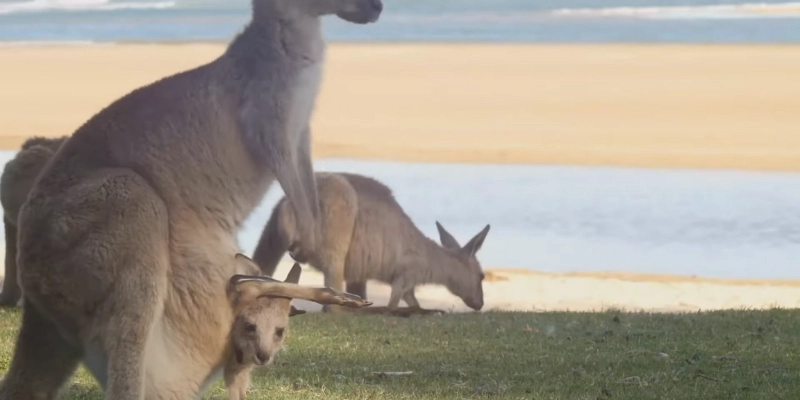
Wombats, platypus, and crocodiles – Each has its own home. Wombats burrow in the ground, platypus swim in rivers, and crocodiles live in the north. Spotting them in the wild is a true adventure.
Tasmanian devil – Native to Tasmania, these small but feisty animals are mostly active at night.
Quokka – Known as the “happiest animal in the world,” quokkas live on Rottnest Island near Perth. They are incredibly friendly and make the perfect photo companions.
Australia isn’t just about animals; its landscapes are equally stunning. From the red deserts of the Outback to lush rainforests and tropical beaches, nature here is as diverse as it is beautiful. When exploring, respect the land, follow local guidelines, and enjoy the wildlife safely.
Currency & Costs
- Currency: Australian Dollar (AUD) – roughly 1 USD = 1.5 AUD
- Notes are colorful and made of polymer; $1 and $2 coins are available.
- Credit/debit cards are widely accepted; cash is rarely necessary.
Living costs in Australia are high. Restaurants, hotels, and transport can be expensive, especially compared to Southeast Asia. Taxes are included in prices, and tipping is optional, usually around 5% at high-end restaurants.
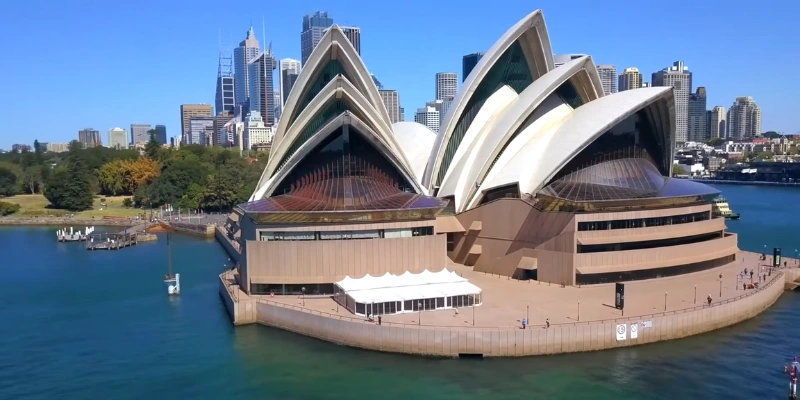
Visa & Entry Information
Before you pack your bags, it’s important to know that most travelers need a visa for Australia. The only exception is citizens of New Zealand, who can enter without one.
For visitors from countries like Pakistan, the USA, Canada, the UK, and many European nations, applying for an Australian travel visa is simple and can be done online. The process is quick; the visa usually costs around 20–50 AUD and is often approved within 24 hours.
Keep in mind, you must get your visa before flying. Airlines will not let you board without proof of a valid visa. Also, make sure your passport is valid for at least six months from your travel date, as this is a common requirement.
There are different types of visas depending on your travel purpose — tourist, business, or transit. So always check the official Australian government website for the most up-to-date information. Doing this ensures a smooth start to your trip and avoids any last-minute stress at the airport.
Having your visa ready is the first step toward exploring the cities, beaches, and natural wonders this amazing country has to offer.
Transportation & Getting Around
Getting around Australia is part of the adventure. The country is huge, so it’s important to plan how you’ll move between cities and explore locally.
Airports & Flights – Sydney and Melbourne have the busiest international airports, making them the main gateways for travelers. Qantas, Australia’s national airline, flies across the country and internationally. If you’re connecting to a domestic flight, allow at least three hours at the airport to clear customs and security.
City Transport – Big cities like Sydney and Melbourne have good public transport systems, including trains, trams, and buses. Other cities are smaller and don’t have as many options, so renting a car can be much easier, especially if you want to explore nearby towns or natural attractions.
Driving in Australia – Australians drive on the left side of the road, which can feel strange if you’re used to right-hand driving. Take it slow, especially in cities, and always follow road signs. Driving is also the best way to see rural areas and the Outback.
Intercity Travel – Traveling between cities is possible in several ways:
- Trains run along the east and south coasts. They’re comfortable but slower than flying.
- Buses, like Greyhound, are cheaper and a good option if you’re on a budget, though the journeys take longer.
- Ferries connect some islands, such as trips to Tasmania.
- Great Barrier Reef trips and other marine adventures usually need organized tours or boats.
When planning your trip, consider travel time, distances, and how you want to get around. Some areas are best reached by plane, while local spots are often easier by car or public transport.
Language & Local Terms
English is the main language in Australia, but travelers quickly notice the unique Australian slang. Knowing a few phrases can make your trip smoother and more enjoyable.
- “Cheers mate” – A friendly way to say thank you.
- “Thongs” – Not what you might think! This means flip-flops or sandals.
- “Takeaway” – Food to go, like fast food or coffee, you take with you.
- “Chemist” – A pharmacy or drugstore.
- “No worries” – It’s okay, you’re welcome, or don’t stress about it.
- “Skinny milk” – Skim milk.
- “Light milk” – Reduced-fat milk (around 2%).
- “Mind the gap” – Watch your step when boarding trains.
- “Feeling dusty” – Hungover.
- “Trading hours” – The opening and closing times of stores.
Learning these terms adds a little fun to your trip and helps you feel more connected with locals. Plus, it makes everyday situations — like ordering food or shopping — easier to navigate.
Beaches & Safety Tips
Australia is famous for its beaches — golden sand, clear water, and endless sunshine. From Sydney’s Bondi Beach to the hidden gems along the Great Ocean Road, the coastline is breathtaking. But while the beaches are beautiful, it’s important to stay safe.
Swim safely – Always swim between the red and yellow flags, where lifeguards are on duty. These flags show the safest areas to enjoy the water.
Watch for hazards – Some beaches have nets to protect swimmers from jellyfish or sharks. Always pay attention to warning signs and follow the instructions — the ocean can be unpredictable.
Keep an eye on your food – Seagulls and other birds can be aggressive and may try to steal snacks. Keep food in bags or containers when not eating.
General safety tips – Never swim alone, avoid strong currents, and check local conditions before heading into the water.
By respecting the rules, you can enjoy Australia’s beaches fully — swimming, surfing, or just relaxing on the sand — without worry. The key is balancing fun with caution.
Shopping & Store Timings
Shopping in Australia is easy, but it helps to know the hours. Most stores open around 10 AM and close between 5 and 7 PM. In big cities like Sydney and Melbourne, many shops stay open later on Thursdays, which is perfect if you want an evening stroll while shopping.
On Sundays, especially in smaller towns, stores and supermarkets may close early or stay shut. If you’re driving through rural areas, plan ahead: refuel your car and stock up on snacks, water, or essentials before heading out.
Food & Local Cuisine
Australian food is hearty and simple, with a strong British influence, but you’ll also find flavors from around the world. Here are some must-try local dishes:
- Sausage rolls – Minced meat wrapped in flaky pastry.
- Meat pies – Savory pies filled with beef or lamb.
- Prawns on the barbie – Grilled shrimp, a classic Aussie barbecue treat.
- Kangaroo, emu, crocodile – Specialty meats served in some restaurants.
- Vegemite – A strong, yeast-based spread often eaten on toast.
- Tim Tams – Chocolate-covered biscuits, a favorite dessert.
Asian cuisines like Chinese, Thai, Japanese, and Malaysian are also very popular, thanks to Australia’s proximity to Asia.
Drinks & Coffee Culture
Australia takes its drinks seriously, both alcoholic and caffeinated.
Beer – The legal drinking age is 18. Common sizes include the schooner (smaller) and pint (larger). Some restaurants have BYO signs, which means you can bring your own alcohol, while No BYO means outside alcohol isn’t allowed.
Coffee – Coffee culture is huge, especially in Melbourne. Australians love espresso-based drinks:
- Cappuccino – Espresso with steamed milk and froth, often topped with chocolate powder.
- Flat White – Espresso with hot milk but no froth.
- Long Black – Espresso with hot water, similar to an Americano.
- Short Black – Straight espresso shot, strong and bold.
Local cafés are more than just coffee stops — they’re cultural experiences. Don’t miss a chance to enjoy a coffee in a cozy laneway café in Melbourne.
Familiar Brands with an Aussie Twist
Travelers from the USA or other countries will notice familiar brand names, but many have local differences:
- Woolworths – A major supermarket chain, not related to the old US store.
- Greyhound Buses – Operates nationwide, unlike the American Greyhound.
- Hungry Jack’s – Australia’s version of Burger King.
- McDonald’s – Locally called Macca’s.
- Domino’s Pizza – Offers unique local flavors like Peking Duck Pizza.
It’s fun to see familiar brands with an Australian twist — a small but memorable part of the travel experience.
Final Tips for Traveling in Australia
Australia is a huge and diverse country, so planning your trip carefully makes all the difference. This Travel Guide for Australia will help you. Since it is impossible to see everything in one visit, focus on one or two regions at a time to get the most out of your journey. The weather can vary a lot depending on where and when you travel.
The north is often tropical and humid, while the south can be cool or even snowy in winter. Always respect wildlife and Indigenous lands by following local rules and signs. It helps keep both you and the environment safe.
Living costs can be high, especially in big cities, so budgeting for meals, transport, and activities in advance is a smart idea. For long-distance travel, flights are the fastest option, while public transport or car rentals work well within cities.
Learning a few local phrases like “Cheers mate” or “No worries” can make your interactions with locals more fun and engaging. With its amazing landscapes, unique wildlife, and lively cities, Australia offers adventures for every traveler. With a little preparation, your trip can be smooth, safe, and full of unforgettable memories.
Get ready to explore Australia and enjoy its amazing cities, beaches, and wildlife. Share this guide with your friends or family who are planning a trip too, so they can have an unforgettable adventure.
FAQs About Traveling to Australia
It depends on where you go. The north is hot and humid, while the south can be cool, even snowy in winter. Summer is December to February, and winter is June to August. Check the weather for your destinations before you go.
Sydney, Melbourne, Canberra, Adelaide, and Perth are the main cities. Sydney has the Opera House and beaches, Melbourne is full of coffee and art, Canberra has museums and calm streets, Adelaide is near wine regions, and Perth is sunny with beautiful beaches.
The Outback, Great Barrier Reef, Blue Mountains, Kakadu National Park, and Freycinet National Park are amazing. You can hike, snorkel, spot wildlife, or just enjoy the incredible views.
You can see kangaroos, koalas, wombats, platypus, crocodiles, Tasmanian devils, and quokkas. Some are in the wild, while others are in zoos. Always be mindful and respectful of their space.
Flights are best for long distances. Trains and buses run along the main coasts, and ferries reach some islands. Cities like Sydney and Melbourne have good public transport, but renting a car is useful for smaller towns. Remember, Australians drive on the left side.
Try local favorites like sausage rolls, meat pies, prawns on the barbie, kangaroo, emu, and Vegemite. Tim Tams are a sweet treat. You’ll also find lots of Asian food like Chinese, Thai, and Japanese.
Yes, but swim between the red and yellow flags where lifeguards are on duty. Watch out for jellyfish, sharks, and strong waves. Keep an eye on your food, too, because seagulls can grab it!
English is the main language, but Australians use a lot of slang. “Cheers mate” means thank you, “No worries” means it’s okay, and “Takeaway” means food to go. Learning these makes your trip more fun.
Australia can be pricey. Hotels, food, and transport cost more than in some other countries. Most places take credit or debit cards. Tipping is optional; at fancy restaurants, it’s usually about 5%. Plan your budget to avoid surprises.

- Be Respectful
- Stay Relevant
- Stay Positive
- True Feedback
- Encourage Discussion
- Avoid Spamming
- No Fake News
- Don't Copy-Paste
- No Personal Attacks

- Be Respectful
- Stay Relevant
- Stay Positive
- True Feedback
- Encourage Discussion
- Avoid Spamming
- No Fake News
- Don't Copy-Paste
- No Personal Attacks



